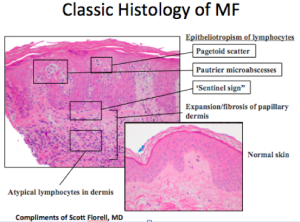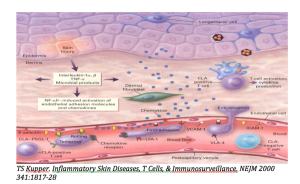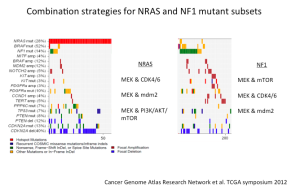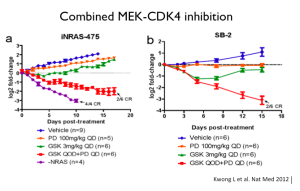Pediatric Dermatology: When to Suspect a Genetic Disease and How to Make a Diagnosis
James Treat, MD
In this presentation, Dr James Treat, an expert in pediatric dermatology, discusses genetic diseases in dermatology and provides us with information on how to make an accurate diagnosis.
Dr Treat reminds us that it is impossible to memorize all of the genetic diseases. As dermatologists, we can identify unusual cutaneous findings, i.e., describe the skin, as this can be helpful in making a genetic diagnosis. Remember that pathways can help you understand the disease(s). If you wonder about a genetic diagnosis, always ask yourself these four important questions:
- Does your patient have two or more unusual findings?
- Is there is a family history of similar findings?
- Is the child developing normally?
- Does the child have dysmorphic features?
Case Study Example
A child presents to your office with congenital red patches. What are they? What should we do about them?
- Does your patient have two or more unusual findings?—Yes, headaches
- Is there is a family history of similar findings?—Two uncles and his father have similar findings and he has an uncle with anyeurism
- Is the child developing normally?—He is having some difficulty in school
- Does the child have dysmorphic features?—No
If you have a patient who has multiple unusual findings OR multiple family members with one unusual finding, use your resources!
- Online Mendelian Inheritance in Man (OMIM)- http://www.ncbi.nlm.nih.gov/omim
- Google scholar- http://scholar.google.com/
- Genetests.org- www.ncbi.nlm.nih.gov/sites/GeneTests/
Technology provides us with an abundance of resources. When we have no idea or no specific search terms, we can use Google; however, we must be cautious in its use. In order to weed out non-scientific website answers, use Google Scholar. Does hand, foot, and mouth affect the buttocks? We can use Google images to search; yet, be aware that many images are mislabeled. OMIM can help when your patient has at least two unusual diagnoses and Genetests.org can aid if you’re wondering if a genetic test is available.
Capillary Malformation-Arteriovenous Malformation Syndrome (CM-AVM)
Dr Treat feels that this is something that is probably under-recognized. It’s a RASA-1 mutation that is associated with multiple capillary malformations that are inherited autosomal dominantly. There is usually a family history of multiple people with these red patches.
Clinical Pearls:
- They look like café-AU-laits, but they are red-purple
- They may all be nascent AVMS, so be careful using a laser
Remember that some patients have AVMs internally; they can be anywhere in the central nervous system and early screening for AVMs can be lifesaving. Given the association with CNS/spinal AVMs, the potential recommended work-up would be to consider an MRI/MRA.
Case Study Example
A patient presents with congenital red patches. He has a very large head with hydrocephalus. There is no other family history and he is developing normally. Does the child have dysmorphic features? Yes, he has a very large head and his 2nd and 3rd toes are fused (syndactyly). If we use our resources (Google Scholar or Google), we will find the name Macrocephaly-Capillary Malformation (and in small writing macrocephaly-cutis marmorata telangiectatica congenital CMTC).. M-CMTC was the name of this disease for a very long time, and went under-recognized because the skin finding is NOT CMTC it is a more recently described entity called a retiulated port wine stain. As dermatologists, we need to be able to tell the difference between the vascular formations.
Associations:
- Macrocephaly
- CM which tends to fade over time and tend to be more evanescent
- 2nd-3rd toe syndactyly
- Developmental delays
How do we diagnosis M-CM?
This disease was recently linked to disruption of the PI3k-AKT signaling. Findings indicative of M-CM are macrocephaly plus capillary malformations and two of the following:
- Asymmetry of overgrowth
- Developmental delay
- Midline facial capillary malformations
- Neonatal hypotonia
- Syndactyly/polydactyly
- Frontal bossing
- Joint hypermobility
- Hyperelastic skin, and hydrocephalus
This patient was diagnosed with hemangioma with arrested growth. How do we make the clinical diagnosis to differentiate hemangioma from capillary malformations and other vascular malformations? Look for red papules, ulceration (commonly seen in hemangiomas in this area), and large telangiectatic blood vessels as well as a peripheral rim of vasocontriction.
Case Study Example
Your patient presents with exuberant warts on the hands. With widespread, severe warts, we ask ourselves if there could be genetic immunodeficiency. Does your patient have other unusual findings? Yes, he has severe atopic dermatitis and always seems to be sick. There is no family history of similar findings, no dysmorphic features, and the child is developing normally.
Combined Immunodeficiency Associated with DOCK8 Mutations
DOCK8 was recently described as a cause of immunodeficiency that leads to severe viral infections, including the infections that we see as dermatologists, as well as upper respiratory tract infections and severe atopic dermatitis.
Most patients with severe atopic dermatitis and a few warts do not have anything wrong with their immune system; however, if you see a patient with terrible warts and terrible atopic dermatitis, you should think about having that patient see an immunologist.
Case Study Example
You notice congenital tan patches on your patient. What are they? Does your patient have other medical problems? No, and it’s only one tan patch. Is there a family history of similar findings? No. Is the child developing normally? Yes. Does the child have dysmorphic features? Yes, a large head.
This patient has neurofibromatosis Type 1 (NF1-). How do we diagnose this? We need two or more of the following: (Note that several of these findings are dermatologic)
- Six or more café-AU-lait spots 1.5cm or larger in post-pubertal individuals, 0.5cm or larger in pre-puberatal individuals
- Two or more neurofibromas of any type or one or more plexiform neurofibroma
- Freckling in the axilla or groin
- Optic glioma (tumor optic pathway)
- Two or more Lisch nodules (benign iris hamartomas)
- A distinctive bony lesion: dysplasia of the sphenoid bone or dysplasia or thinning of long bone cortex
- A first-degree relative with NF-1
What if you are sure that your patient has NF-1 and the testing is negative? You can also test for SPRED1.
SPRED1 is a novel mutation in the same pathway regulated by Neurofibromin, It is part of the SPRED/SPROUTY family which regulates MAP kinase activity (as does Neurofibromin). Most patients reported were adults and did not have other sequalae of NF-1. These patients have some increased risk of cognitive and developmental behavior abnormalities.
What is your workup in a healthy ten year-old with an isolated congenital flat tan patch?
- Send blood to evaluate for GNAS1 mutation
- Reassure
- Send blood to evaluate for NF-1 mutation
- Send blood to evaluate for SPRED1 mutation
These consults can be frustrating because we don’t always know what else can be doing on. Segmental pigmentary disorders (block-like, midline cutoff, isolated) have clinical characteristics that are reassuring as there is normally nothing else going on. Other diagnoses to be considered:
- McCune Albright (typically multiple darker patches along thick lines of blaschko)
- Neurofibromatosis (typically >6 oval smaller patches)
- SPRED1 (same clinical café au lait macules as NF1)
- Speckled Lentiginous nevi (by early childhood can often see the speckling within the larger tan patch)
Conclusions
You, as the dermatologist, have the power of accurate skin description. Look for capillary malformations, warts that are a bit too exuberant and café-AU-lait macules versus other pigmentary disorders. If you suggest a genetic disease, ask the important questions and utilize the resources that technology has provided us.
MauiDerm News Editor-Judy Seraphine






